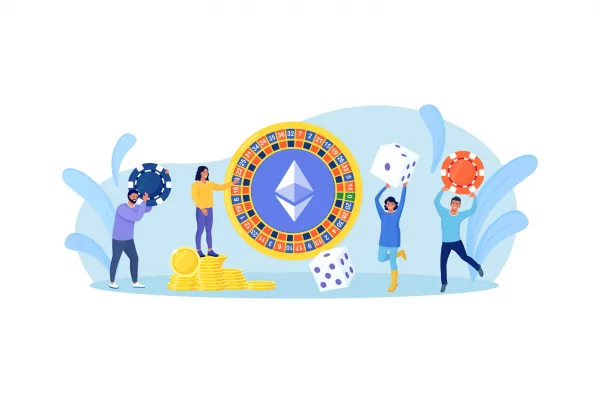
Right now, we’re still in the early days of Web3 games, which have adopted technologies like cryptocurrencies and NFTs to create a new concept known as “play-to-earn”. These games are mainly focused on making money for players rather than on fun and engaging gameplay, but this focus is a recipe for disaster and, as we’ve seen, is unlikely to achieve long-term success.
For Web3 gaming to succeed, projects need to build atop of the best bits of Web2 gaming. The success of AAA games like Grand Theft Auto and Fortnite boils down to one thing. They’re exciting games that people love to play, created by some of the industry’s top developers and entrepreneurs. They’re engaging and rewarding, and they understand the psychology of gamers so well that they keep on coming back for more and more. People play games to have fun, and there’s zero focus on making games profitable – at least not for the players themselves.
For Web3 games that wish to incorporate play-to-earn elements, they need to build on the principles that worked so well for the top Web2 games, adding new capabilities in order to make the experience even more fulfilling. The first Web3 games that adopt this evolutionary concept instead of trying to be revolutionary can potentially change the way players interact with games forever.
Interest In Web3 Gaming Is Growing
Although the earliest Web3 games developers got it all wrong with their focus on making money, there’s no denying that the concept has attracted a great deal of interest. According to DappRadar, Web3 games accounted for almost 50% of all blockchain activity in 2022, with more than 1.13 million unique active wallets connecting to gaming dApps every single day. That represents an increase of 60% from the prior year. In another sign of its growing popularity, Web3 game and metaverse projects were able to raise $7.6 billion in funding in 2022, up 59% from the year before.
Of course, Web3 game adoption remains pathetically low compared to the biggest AAA Web2 games. Grand Theft Auto 5 alone is bigger than the entire Web3 gaming industry, with more than 1.29 million unique daily players, according to a report by Fiction Horizon.
Still, the growing interest and current low level of adoption in Web3 gaming means only one thing – it’s an area that has huge potential, if only games developers can get it right. But there’s a lot of work to be done.
A Cautionary Tale
The best-known Web3 game by far is Axie Infinity, a game that has received lots of attention for its ability to make some players rich, as well as much criticism from others. Axie notably hit the headlines for all the wrong reasons last year when it suffered a network breach that resulted in it losing more than $620 million worth of crypto tokens. The game has seen its user numbers decline substantially since that hack occurred, though a closer look reveals that this loss of interest actually began some time before it was hacked.
While Axie Infinity certainly did well, its story is really a cautionary tale for Web3 game developers. While its developer Sky Mavis tried to create a decent gameplay experience, the real attraction of Axie Infinity was always its economic benefits.
At some point in 2021, it was claimed that certain players were earning in excess of $1,000 a month by playing the game full-time, a very decent wage in countries like the Philippines, where as many as 40% of Axie’s players are based. Ultimately though, Axie’s success proved unsustainable as its game economy was based on its ability to continually attract new players and fresh capital into its ecosystem. Playing Axie requires an NFT, and these can sell for hundreds of dollars, making it a serious upfront investment.
The initial excitement around Axie drove demand for those assets, but as the excitement abated and NFT prices increased, it struggled to attract new users. Eventually, the percentage of new users compared to the total number of users decreased to a point where it was no longer attracting enough capital to sustain the price of its assets. As such, NFT values plummeted, as did the value of its in-game rewards, leading to an inevitable decline of interest as players found they could no longer earn a living playing a game that wasn’t even all that entertaining.
The Axie Infinity story shows us that Web3 gaming cannot sustain itself as a play-and-earn revolution. What Web3 needs are great games that give people a reason to want to play, not just an economic incentive.
Learning From eSports
The Web3 gaming industry could perhaps learn a thing or two from eSports, which have already created a successful economic model atop of the Web2 gaming industry. eSports arose in the 1990s when games publishers first began sponsoring official tournaments and awarding prize money to the winners. By the 2010s, these contests had grown into a standalone industry with professional teams, millions of fans and robust revenue streams. eSports revenues in 2023 are expected to top $1.5 billion.
The eSports industry is dominated by AAA multiplayer games like Fortnite, League of Legends, CS.GO, Dota 2 and PUBG, which are all hugely popular in their own right. Competitions in eSports offer lucrative prize pools for the most successful teams, but there are a number of problems with the current model that could be improved with Web3 technologies.
For one thing, there is a huge barrier to entry into professional eSports, and the industry is known for its dishonest behavior. There have been numerous instances of cheating in eSports tournaments. For instance, the “322” meme was coined by the Dota community on Reddit and Twitch after one well-known player chose to “throw” a game in order to profit by betting on the outcome. The player allegedly placed a bet on his opponent using his girlfriend’s betting account, winning at odds of 3.22.
Another problem with eSports is its economic model, where prize money is generally offered by the game publishers who make huge profits from these competitions. Not only do they get recognition from the publicity such competitions generate, but they also keep a significant portion of the entry fees paid by players.
Web3 could potentially solve these problems and create better opportunities for players, while providing incentives for content creators, developers and even viewers. Innovations such as digital ownership bring obvious benefits to players, while blockchain and smart contracts can solve issues around accounting, ticketing, authentication and scoring in a more transparent way. Fans can check the profiles of players with confidence that the data is true, and certify that their ownership of digital items is authentic. With the transparency of blockchain, everyone can see what is happening within the eSports ecosystem, creating more confidence for its participants.
Smart contracts are a perfect solution for agreements between players entering an eSports tournament, ensuring that the distribution of prize money is both fair and transparent, and not susceptible to any corruption.
eSports and Web3 Come Together
The eSports and Web3 communities have already begun exploring the possible ways they can benefit each other, resulting in the creation of a number of promising initiatives.
For instance, in January, Singapore’s professional Esports Players League, which hosts tournaments for Web2 games like CS:GO, PUBG Mobile, Call of Duty and other well-known titles, announced a new “Host-to-Earn” model alongside its new $ARENA token. With this new model, ESPL aims to simplify how online tournaments are organized and provide a secure and transparent way for prize money to be distributed among participants. Crucially, users can organize tournaments for free, with players paying a small entrance fee in $ARENA for the chance to win money from other participants.
ESPL’s platform makes it possible to organize both public tournaments open to anyone, as well as exclusive competitions open to invited players only. Smart contracts are used to escrow prize money, ensuring that the winners will be paid in a timely manner once the tournament concludes. It also includes a marshall system, where the tournament organizers are able to adjudicate in the event of any disputes between players.
A similar idea with a perhaps much broader scope is Moxy.io, which has created an ecosystem that enables any Web2 game to introduce eSports modes using Web3 technologies. Using the platform, players purchase their favorite games from the Moxy game store. Not only do they get the base game, but they also get an enhanced eSports mode on that game that allows them to play against others for a fee and try to win money. Moxy leverages blockchain to create a universal token that’s used for both entrance fees and rewards, with each player getting their own digital wallet that’s usable across every game hosted on the Moxy platform.
The benefit for publishers is that they get immediate access to a global audience of players and the tools required to tap into it. The Moxy platform provides a simple API integration stack that can integrate with existing console, PC and mobile games, enabling developers to quickly add eSports modes to their games.
Also promising is the Stadium Project, which is building an eSports dApp and permissionless tournament protocol on the Ethereum blockchain. The project is aimed at communities that want to organize self-hosted tournaments for their favorite games, with tools for creating leagues with entrance fees and a decentralized environment for managing those competitions. The platform also includes rosters of gamers with profiles and statistics for each one, enabling players to study each one when assembling their squads. Stadium is still a work in progress, but is already working with some major eSports events organizers, including Gods Unchained and Stadium Spartan Series.
Final Thoughts
The earliest Web3 games have mostly been focused purely on profit making rather than on providing entertainment for players, and as we have seen, it’s a strategy that has backfired. Web3 games are still a new concept, but have already attracted a lot of hostility and scorn from “true” gamers who’re in it for the enjoyment.
On the other hand, eSports has largely gotten it right with an economic model that builds on the popularity of the world’s biggest AAA games. By merging eSports with Web3, we can potentially solve some of the biggest challenges associated with eSports, including accounting, cheating, a lack of transparency and unfair prize distribution. Web3 and eSports can bring us the best of both worlds, with high-quality games, more balanced tournaments and a fairer distribution of prize money, giving every player a chance to profit while enjoying the games they love.



